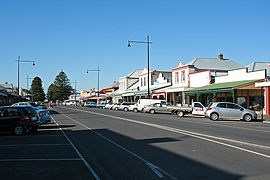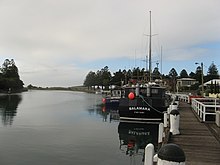Port Fairy
| Port Fairy Victoria | |||||||||
|---|---|---|---|---|---|---|---|---|---|
 The main shopping precinct | |||||||||
| Coordinates | 38°22′0″S142°14′0″E/ 38.36667°S 142.23333°E | ||||||||
| Population | 3,340 (2016 census)[1] | ||||||||
| Established | 1843 | ||||||||
| Postcode(s) | 3284 | ||||||||
| Elevation | 6 m (20 ft) | ||||||||
| Location |
| ||||||||
| LGA(s) | Shire of Moyne | ||||||||
| State electorate(s) | South-West Coast | ||||||||
| Federal division(s) | Wannon | ||||||||
| |||||||||
Port Fairy(historically known asBelfast) is a coastal town in south-westernVictoria, Australia.It lies on thePrinces Highwayin theShire of Moyne,28 kilometres (17 mi) west ofWarrnambooland 290 kilometres (180 mi) west ofMelbourne,at the point where theMoyne Riverenters theSouthern Ocean.
History
[edit]


Prior to British colonisation in the 19th century, the Port Fairy area, then known as Pyipkil or Ummut, was inhabited by thePyipkil gunditjclan, also known as the Yarrer gunditj.[3]They spoke the Peek Whurrong language.[4]The region's ecology consisted of denseBanksia-dominated bushland and large swamps.[5]The Pyipkil gunditj constructed stone and timber fishing-weirs calledyererocacross creeks to catch fish and eels. They also cut canals calledvamto drain swamps and made woven eel-pots calledarabineto trap eels.[3]TheEastern Maarpeople are now considered[by whom?]the traditional owners of the Port Fairy area.
In the early 19th centurywhalersandseal huntersused the coast in this region.[6]The crew of the sealing cutterThe Fairy(Captain James Wishart) reportedly gave the bay its current name in 1828.[7][8]Whatever its origins, the name "Port Fairy" had come into general use by 1835.[9]
John Griffiths[10]established awhaling stationin 1835, and a store opened in 1839. In 1843 James Atkinson, aSydneysolicitor, purchased land in the town byspecial survey.He drained the swamps, subdivided and leased the land, and built a harbour on the Moyne River. He named the town "Belfast"after his hometown inIreland.
In the 1840s significant conflict between pastoral squatters andAboriginal peopleoccurred. 1842 saw 27squatters fromthe Port Fairy neighbourhood signing a letter toCharles Latrobe,the Superintendent of thePort Phillip District,reporting many "outrages" committed by the "natives" and requesting the government provide security. These clashes, later known as theEumeralla Wars,formed part of the battle over land use and resources between traditional owners and Europeans across the Victoria'swestern district.[11]
The post office opened either in 1837[citation needed]or on 1 July 1843 as "Port Fairy", but was renamed "Belfast" on 1 January 1854[12]before reverting to the original name on 20 July 1887.
Agriculture developed in the region, and Belfast became an important transport hub.
By 1857 the town had a population of 2,190. In 1887 the town was renamed "Port Fairy" as a result of an Act of Parliament.[citation needed]
A railwayextended to the town in 1890, but closed in 1977.[13]It has been converted into thePort Fairy to Warrnambool Rail Trail.
The Port Fairy Magistrates' Court closed on 1 January 1990.[14]
Traditional ownership
[edit]The formally recognisedtraditional ownersfor the area in which Port Fairy sits are theEastern Maarpeople,[15]who are represented by the Eastern Maar Aboriginal Corporation (EMAC).[16]
Town
[edit]At the2016 census,Port Fairy had a population of 3,340.[1]Its main industries aretourismandfishing,and it is the home port for one of Victoria's largest fishing fleets. A pharmaceutical factory owned bySun Pharmais located on the outskirts of the town. Port Fairy is home to two primary school education facilities, The Port Fairy Consolidated School[17]and St. Patricks Parish Primary School.[18]
Port Fairy was voted as one of theworld's most livable citieswith a population under 20,000 after winning the 2012 International LivCom award.[19]
Port Fairy has a rich history, and 50 buildings are protected by theNational Trust of Australia.Griffiths Islandnearby holds a breeding colony of theshort-tailed shearwateror Australian muttonbird.
Festivals
[edit]ThePort Fairy Folk Festivalis held during the Labour Day long weekend in March each year. The festival has run continuously since 1977. In 2016, Port Fairy celebrated the 40th edition of the Folk Festival from 11 to 14 March. Over the 40 festivals there have been around 3,500 acts including over 500 international acts and over 12,000 musicians to an audience of beyond 240,000 ticket holders and 1,000,000 attendees.[20]
The inaugural Port Fairy Spring Music Festival was held in 1990, founded by British/Australian composerMichael Eastonand pianist Len Vorster, and is run annually. The open-air festival, which is free to attend, focuses on classical and contemporaryensemblemusic, and also includes drama, orchestral and choral music,jazz,opera, and dance. Its pastartistic directorshave included Vorster,Marco van Pagee(who also founded theMelbourne International Chamber Music Competitionin 1991 and was in 2009 artistic director ofChamber Music Australia[21]), Erich Fackert, Stephen McIntyre,Anna GoldsworthyandIain Grandage.As of 2023[update]its program includes 24 performances over three days, and the artistic directors are Monica Curro and Stefan Cassomenos.[22]
The annual Moyneyana Festival is held over summer from Christmas Eve to 26 January.[23]
The annual Tarerer Festival, taking place over a weekend, is a celebration of the region's multicultural identity, its history relating to itsAboriginal peoples(Koori, in particular those of the Warrnambool district[24]), and the environmental significance of the land. It features music and dance as well as art and performance workshops, and includes music from a variety of cultures, including non-Indigenous ones.[25]Begun in 1996 by a group of people inFramlingham Forest,it is the only festival of its kind in Victoria. The name derives from the Aboriginal name forTower Hill,the nearby area of volcanic lakes. In 2008, it featured therock reggaeband of the 1980s,No Fixed Address,as well as aSudaneseband.[24]
Sports and recreation
[edit]Port Fairy also has a highly rated 18-holelinks golf course,the Port Fairy Golf Club, situated on Woodbine Road. Made famous when local young stud Kaidyn Phelan sunk an ace on hole 3 during the 2009 Port Fairy Masters, earning him the famous golden shearwater award and cementing his status as greatest golfer in west Port Fairy.[26]
The town has anAustralian rules footballteam, thePort Fairy Seagulls,which plays in theHampden Football League.[27]
Port Fairy has many surfing spots for all skill levels including the Old Passage, a right hand rocky break at the old entrance to the Moyne river; the Lighthouse, a right-hand point break off Griffiths island; and the East Beach with many right and left beach breaks.
Notable people
[edit]This sectionneeds additional citations forverification.(January 2024) |
- Sir Frank Macfarlane Burnet(1899–1985), Nobel Prize-winning virologist, died in Port Fairy
- John Coleman(1928–1973), Australian rules footballer
- Brian Dunlop(1938–2009), painter[28]
- Denis Napthine,Premier of Victoria2013–2014
- T. J. Ryan,Premier of Queensland1915–1919
- Jock Serong
Climate
[edit]| Climate data for Port Fairy (1991–2020 normals, extremes 1990–present) | |||||||||||||
|---|---|---|---|---|---|---|---|---|---|---|---|---|---|
| Month | Jan | Feb | Mar | Apr | May | Jun | Jul | Aug | Sep | Oct | Nov | Dec | Year |
| Record high °C (°F) | 44.3 (111.7) |
42.1 (107.8) |
41.3 (106.3) |
36.1 (97.0) |
28.7 (83.7) |
23.2 (73.8) |
20.9 (69.6) |
25.2 (77.4) |
31.3 (88.3) |
35.7 (96.3) |
38.5 (101.3) |
45.2 (113.4) |
45.2 (113.4) |
| Mean daily maximum °C (°F) | 22.7 (72.9) |
22.8 (73.0) |
21.6 (70.9) |
19.4 (66.9) |
16.8 (62.2) |
14.7 (58.5) |
14.2 (57.6) |
15.0 (59.0) |
16.6 (61.9) |
18.3 (64.9) |
20.0 (68.0) |
21.3 (70.3) |
18.6 (65.5) |
| Mean daily minimum °C (°F) | 14.1 (57.4) |
14.6 (58.3) |
13.1 (55.6) |
10.9 (51.6) |
9.2 (48.6) |
7.5 (45.5) |
6.9 (44.4) |
7.3 (45.1) |
8.3 (46.9) |
9.4 (48.9) |
11.2 (52.2) |
12.6 (54.7) |
10.4 (50.7) |
| Record low °C (°F) | 4.6 (40.3) |
5.6 (42.1) |
5.3 (41.5) |
0.3 (32.5) |
0.4 (32.7) |
−1.3 (29.7) |
−1.0 (30.2) |
0.1 (32.2) |
0.4 (32.7) |
1.4 (34.5) |
2.7 (36.9) |
3.4 (38.1) |
−1.3 (29.7) |
| Average rainfall mm (inches) | 30.3 (1.19) |
28.6 (1.13) |
36.9 (1.45) |
49.7 (1.96) |
69.6 (2.74) |
75.1 (2.96) |
88.8 (3.50) |
87.6 (3.45) |
69.1 (2.72) |
53.4 (2.10) |
45.5 (1.79) |
41.5 (1.63) |
678.6 (26.72) |
| Average rainy days(≥ 1.0 mm) | 4.2 | 3.6 | 6.2 | 8.1 | 11.6 | 12.0 | 14.7 | 14.9 | 11.6 | 9.2 | 6.7 | 5.9 | 108.7 |
| Source: Australian Bureau of Meteorology (rain 1994-2020)[29] | |||||||||||||
References
[edit]- ^abAustralian Bureau of Statistics(27 June 2017)."Port Fairy (State Suburb)".2016 Census QuickStats.Retrieved7 July2017.
- ^"A rollicking good tale".Seacombe House website.Archived fromthe originalon 26 March 2010.Retrieved6 January2010.
- ^abClark, Ian D; Robinson, George Augustus (2014).The Travels of George Augustus Robinson, Chief Protector, Port Phillip Aboriginal Protectorate 1839 - 1852.
- ^Dawson, James (1881).Australian aborigines: the languages and customs of several tribes of aborigines in the western district of Victoria, Australia.Melbourne: Robertson.
- ^Powling, J.W. (1980).Port Fairy, the first fifty years.Maryborough: McPherson's.
- ^Neil, Jan; Sayers, M. C (1973),Port Fairy: pioneer whaling station,Mullaya Publications,ISBN978-0-85914-007-2
- ^"Portland Bay Extracts",The Sydney Morning Herald,p. 4, 23 March 1843,retrieved13 February2011,quoting thePortland Mercury.
- ^Cox, Philip & Stacey, Wesley (1973),Historic towns of Australia,Melbourne, Lansdowne, p. 146.ISBN0701801840
- ^“Port+fairy” |||dateTo|||dateFrom|||sortby=dateAsc Launceston Advertiser, 26 November 1835, p. 3
- ^ "Griffiths, John (1801–1881)".Australian Dictionary of Biography.Vol. 1. Canberra: National Centre of Biography,Australian National University.1966.ISBN978-0-522-84459-7.ISSN1833-7538.OCLC70677943.Retrieved15 February2011.
- ^"NATIVES AT PORT FAIRY".Launceston Courier.Vol. II, no. 76. Tasmania, Australia. 18 April 1842. p. 2.Retrieved13 January2019– via National Library of Australia.
- ^Phoenix Auctions History,Post Office List,retrieved20 January2021,
Port Fairy (1) PO 1/7/1843; renamed Belfast PO 1/1/1854.
- ^Sid Brown (March 1990), "Tracks Across the State",Newsrail,Australian Railway Historical Society (Victorian Division), pp. 71–76.
- ^ "Review of Legal Services in Rural and Regional Victoria"(PDF).Parliament of Victoria Law Reform Committee. May 2001. pp. 291–292.Retrieved12 April2020.
- ^"Map of formally recognised traditional owners".Aboriginal Victoria.Retrieved2 June2020.
- ^"Eastern Maar Aboriginal Corporation".Eastern Maar Aboriginal Corporation.Retrieved2 June2020.
- ^The Port Fairy Consolidated School,retrieved5 August2015
- ^St Patrick's Parish Primary School Port Fairy,retrieved5 August2015
- ^John Davis,Port Fairy,archived fromthe originalon 14 February 2017,retrieved3 May2014
- ^"The 40th Port Fairy Tales Project".Retrieved5 August2015.
- ^Goldsworthy, Anna (15 June 2009)."Creating our own star chamber".The Age(Interview). Interviewed by Usher, Robin.Retrieved13 November2023.
- ^"About the Festival".Port Fairy Spring Music Festival.15 August 2022.Retrieved14 November2023.
- ^"Moyneyana Festival".Ozevents Online.3 May 2020.Retrieved22 April2021.
- ^abJackson, Andra (15 November 2008)."Tarerer festival a Koori showpiece at home in the sand dunes".The Age.Retrieved22 April2021.
- ^"Tarerer Festival".I AM PORT FAIRY.Retrieved22 April2021.
- ^Golf Select,Port Fairy,retrieved11 May2009
- ^Full Point Footy,Port Fairy,archived fromthe originalon 6 October 2008,retrieved25 July2008
- ^[1][dead link]
- ^"Climate statistics for Australian locations- PORT FAIRY AWS".8 July 2024.
External links
[edit]![]() Media related toPort Fairyat Wikimedia Commons
Media related toPort Fairyat Wikimedia Commons


